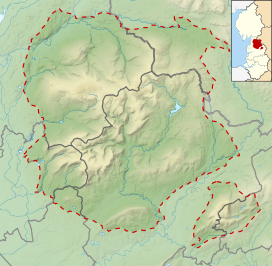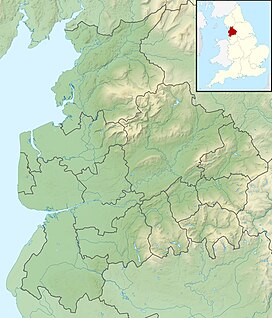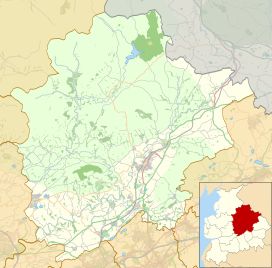Fair Snape Fell
This article needs additional citations for verification. (February 2024) |
| Fair Snape Fell | |
|---|---|
 Fair Snape Fell from the south-west | |
| Highest point | |
| Elevation | 521.9 m (1,712 ft)[1] |
| Prominence | 226.2 m (742 ft) |
| Parent peak | Ward's Stone |
| Listing | Marilyn |
| Coordinates | 53°55′10″N 2°36′54″W / 53.91936°N 2.61509°W |
| Geography | |
| Location | Lancashire, England |
| Parent range | Forest of Bowland |
| OS grid | SD597472 |
| Topo map | OS Landranger 102 |
Fair Snape Fell is one of the larger hills in the Forest of Bowland in Lancashire, England. It reaches 521.9 m (1,712 ft) with a prominence of 226.2 m (742 ft) and is classed as a Marilyn.[1] It occupies a position in the very south of the main range of fells, alongside and just to the north of Parlick, to which it is joined by a ridge. The main paths approach the summit from Parlick in the south, Saddle Fell in the east and Bleasdale in the valley to the west. The Saddle Fell approach is as boggy as the hills to the north. The summit is covered in grass and peat groughs. A trig point and large cairn occupy the top of the western escarpment, with the highest point being about 700 metres (770 yd) to the north-east.
The word snape means "pasture"; thus Fair Snape Fell means "fell of the fair (beautiful) pasture".[citation needed]
Considerable areas of the Bowland fells were used for military training during World War II and there are still unexploded bombs in some areas, including nearby Wolf Fell.[citation needed]
-
Fair Snape Fell (left) and Parlick (right) viewed from the west
-
View from the trig point on Fair Snape Fell, looking down on Parlick.
References
[edit]- ^ a b "Fair Snape Fell". Hill Bagging. Database of British and Irish Hills. Retrieved 2 February 2024.








